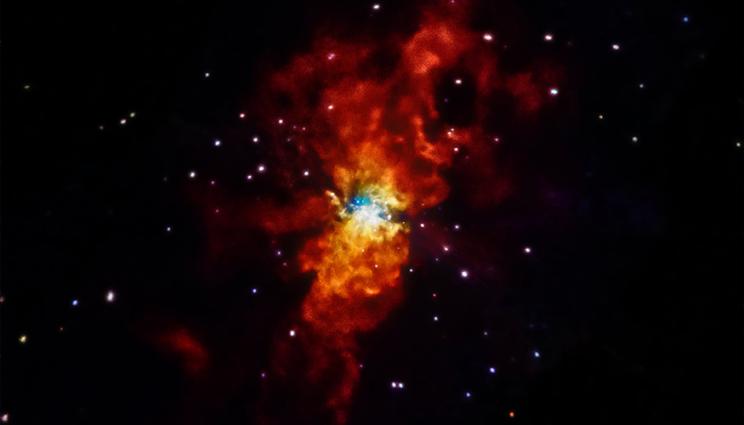
A team of researchers, including scientists from Lawrence Livermore National Laboratory, have detailed the creation of magnetic fields formed by the expansion of supernova explosions into the interstellar medium. Image courtesy of NASA.
In a paper recently published by Physical Review Letters, a team of researchers including scientists from Lawrence Livermore National Laboratory (LLNL) detail the first quantitative measurements of the magnetic field structure of plasma filamentation driven by the Weibel instability, using a novel optical Thompson scattering technique.
These experiments study the processes responsible for the formation of collisionless shocks, phenomena that is observed in astrophysical settings, such as the expansion of supernova explosions into the interstellar medium. The particles from these explosions and the interstellar medium are at a very low density and might travel light-years without colliding.
However, the plasma is able to self-generate strong magnetic and electric fields. As the streams of plasma pass through one another, they become susceptible to the Weibel instability - a plasma instability present in some electromagnetic plasmas - causing the two interpenetrating flows to "filament" and clump together into separate streams. Magnetic fields wrap around these filamented flows, increasing the degree of filamentation.
The plasma amplifies these magnetic fields until they become strong enough to completely turn the particles around. At that point the flow stops and the collisionless shock is formed. The powerful magnetic fields associated with the shock have another effect - their turbulent motion in the plasma accelerates charged particles to high energy, producing cosmic rays that can be observed on Earth. The Weibel instability is the most critical element in the shock formation process.
"The aim of the experiments is to investigate the dynamics of the Weibel instability," said George Swadling, LLNL physicist and lead author on the paper. "While the effects of filamentation had been observed in previous experiments using proton-radiography, no direct measurements had been made of the plasma dynamics. These direct measurements can be used to very directly benchmark the theoretical and numerical models, which are used to understand the growth and development of this instability.
"These processes occur at scales that are too small to observe in astrophysical systems, so lab experiments provide the best opportunity to be able to test the theoretical models," he added. "In this case, we were able to constrain the model used to predict the maximum strength of the magnetic fields produced by this process."
Using the OMEGA facility at the University of Rochester's Laboratory for Laser Energetics, the team heated pairs of 1-millimiter-diameter beryllium disks using 1-nanosecond laser pulses. The heated surfaces expanded, producing plasma flows with peak speeds of 3.3 million miles per hour. The researchers collided the flows and studied the behavior plasma at the collision center using the optical Thomson scattering diagnostic, which measures the temperature, density and velocity of the plasma streams, allowing them to directly observe the formation of plasma filaments due to the Weibel instability and to measure the current and magnetic field associated with those filaments.
"An enormous amount of theoretical and simulation work has been carried out to understand how this instability develops and how it can form shocks and accelerate particles. The experimental evidence to test these theories has however been wanting," Swadling said. "Our highly quantitative data therefore represents one of the best opportunities yet to test the theoretical models and simulation codes used to predict these phenomena."
Looking ahead, the team will apply what they learned in this campaign to benchmark the particle in cell models used to design experiments and make more measurements when the instability has developed further, allowing them to observe the transition from the unstable plasma to the fully formed shock state.
Co-authors on the paper include Drew Higginson, Channing Huntington, Hye-Sook Park, Bradley Pollock and Steven Ross from LLNL; Colin Bruulsema and Wojciech Rozmus from the University of Alberta; Frederico Fiuza from SLAC National Accelerator Laboratory; Hans Rinderknecht and Joe Katz from the University of Rochester's Laboratory for Laser Energetics; and Andrew Birkel from the Massachusetts Institute of Technology. Bruulsema also served as a summer scholar in LLNL's National Ignition Facility and Photon Science Directorate in 2019.






